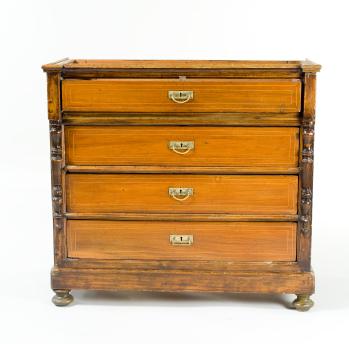Antique Furniture Value – Should You Refinish, Or Not?
Media Gallery
It’s easy to become so addicted to refinishing that you want to redo everything in sight. While that’s fine for modern pieces, antiques, especially rare ones, can actually have value destroyed by refinishing! So how do you know it’s safe to refinish or restore?
There are a couple keys.
The first indicator is age. Sometimes the date of manufacture is stamped somewhere on the piece. If it’s less than 100 years old, you can strip, sand, and stain away without fear; it’s officially not an antique and is likely mass-produced. If there’s no date, the style of the piece can be a good indicator of age.
The value of antique furniture can vary widely, even when dealing with very old pieces. There are plenty of “antiques” out there that aren’t worth much. These, too, can be refinished or restored relatively guilt-free. If it’s obvious a piece has been refinished in the past, or if repairs are obvious (some sections are obviously constructed of new wood, while other portions are older), the previous owner may very well have destroyed any value the antique might have had. Refinish it how you like, or return it (as best you can) to its former glory through restoration.
Another time you might consider restoring or refinishing a piece is if it’s badly damaged. If it’s unusable as-is, with lots of broken pieces, dry rot, or raw, unprotected wood, carefully restoring the piece will add to its value. Here, too, it’s important to understand the potential value of the piece before beginning. On common or cheap items, the average hobbyist can handle restoration at home. For rare items, however, a professional will be better able to preserve the item’s integrity and value.
If the piece seems old and looks like it’s in relatively good, original condition, your best bet is to have the piece appraised by a professional. Most large cities have companies who specialize in appraising antique furniture. Look in the yellow pages under “appraisal services” or “antique furniture.” Be sure to ask if the appraiser is “accredited” or “certified.” This is one area where you need a true professional, not a hobbyist! Another option is to contract an auction house to conduct the appraisals for you. This may be a good idea if you’ve inherited a whole houseful of goods, or if you’re lucky enough to buy a storage unit full of old furniture at auction.
If you can’t find any appraisal services that specialize in antique furniture valuation, you may need to do a little research on your own. There are plenty of books available to help you determine value of your antique. The internet is also a good starting point; it helps to know what style the furniture is, who the manufacturer is (like the date, this information can sometimes be found stamped or written in an inconspicuous place, like the inside of a drawer), and what, if any, work has been done to it (check worn edges to determine if it has been painted multiple times, check joints for glue, nails, and screws that might indicate repairs, and peek at the edges of upholstered seats to see if the original fabric may have been covered over .)
Next, pay attention to the construction and details of the piece. The more detailed an item is, the better the chances that you’re holding on to a valuable antique. Ornately carved legs or panels, and elaborate painting or gilding (if original) add value; complicated highboys and desks with many moving parts will command a higher price than a simple armoire with plain shelving inside.
Then, determine if the piece would be usable in today’s world. Huge, heavy pieces aren’t the most valuable; in fact, most collectors prefer items that can be taken with them when they move, used daily, and otherwise enjoyed.
Finally, understand that a single antique piece may be valued in several different ways. For example, the replacement value listed on an insurance policy may not be the same value the piece would command at auction. Be sure to take this into consideration when determining the value of your piece.
The Bottom Line
The rule of thumb for refinishing antiques is “when in doubt, don’t.” You can always go back and personalize or restore the item later if you determine it’s not as valuable as you thought it was. Nothing, however, will bring back an authentic antique’s patina, charm, and value once it’s been refinished.


